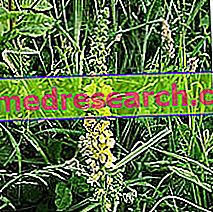
Scientific name
Agrimonia eupatoria L.
Family
Rosaceae
Origin
Europe
Used Parts
Drug consisting of the flowering tops of agrimony, which must contain at least 2% of tannins expressed as pyrogallol.
Chemical constituents
- flavonoids (quercetin, kaemferol, luteolin, apigenin);
- tannins condensed to a variable extent (catechic tannins).
Agrimonia in Herbalist: Property of the Agrimony
The main property of the agrimony is the local and topical disinfectant on skin and mucous membranes. The only correct clinical indications, confirmed for internal use, are the treatment of pharyngitis, stomatitis, and mild acute diarrhea, while for external use the drug can be used for the treatment of exudative dermatitis, abrasions and wounds (in the dermato-cosmetic field the agrimonia boasts in fact anti-inflammatory, soothing, refreshing, astringent, antiseptic and sebum-regulating properties).
Biological activity
The agrimony is a plant with local astringent and disinfectant properties, which are conferred by the tannins it contains.
For this reason, the use of this plant has received official approval for the treatment of diarrhea, skin inflammation and inflammation of the oropharyngeal cavity.
Furthermore, hematoprotective, depurative, decongestant and choleretic properties are attributed to agrimony. However, there are no clinical studies that can confirm these activities.
Agrimony against diarrhea
Thanks to the astringent activity conferred by the tannins, agrimony constitutes a valid remedy that can be used to counteract diarrhea.
For the treatment of this disorder, the plant must be taken internally.
In general, it is recommended to take about 3-6 grams of drug per day.
Agrimony against inflammation of the skin and the oropharyngeal cavity
As mentioned, the agrimony is endowed with local disinfectant properties, which are performed above all against skin and mucous membranes. For this reason, its use has been officially approved to treat cutaneous and oropharyngeal inflammation.
Of course, for the treatment of this type of ailment, agrimony must be used externally. It is usually recommended to prepare a 10% decoction to be used for rinses and gargles in case of inflammation of the oropharyngeal cavity, or to be applied directly on the affected area in case of skin inflammation.
Agrimony in folk medicine and homeopathy
In folk medicine, agrimony is used internally for the treatment of a wide variety of disorders, such as diarrhea, inflammation of the oral mucosa, inflammation of the kidneys and bladder, cholestasis, diabetes and nocturnal enuresis in children.
Externally, however, traditional medicine exploits this plant for the treatment of wounds from difficult healing, chronic pharyngitis, psoriasis and seborrheic eczema.
In Chinese medicine, on the other hand, agrimony is used as an anthelmintic and antitumor remedy.
The agrimony is also exploited by homeopathic medicine, where it can be found in the form of granules. In this context the plant is used in case of cough and sore throat.
The dose of homeopathic remedy to be taken may differ from individual to individual, also depending on the type of disorder to be treated and depending on the type of preparation and homeopathic dilution that is intended to be used.
Side effects
Due to the high content of tannins, following the intake of high amounts of agrimony or its preparations, digestive disorders and constipation may occur.
Contraindications
Ascertained hypersensitivity to one or more components.
Pharmacological Interactions
Prolonged intake of Agrimonia eupatoria can lead to interactions with the absorption of many drugs, depending on the high content of drug tannins (possible interactions with oral hypoglycemic agents).



